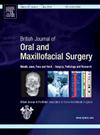Reclassifying cT4b buccal mucosa/gingivobuccal complex cancers: do we need to change?
IF 1.7
4区 医学
Q3 DENTISTRY, ORAL SURGERY & MEDICINE
British Journal of Oral & Maxillofacial Surgery
Pub Date : 2025-01-01
DOI:10.1016/j.bjoms.2024.08.004
引用次数: 0
Abstract
T4b carcinomas are termed as very locally advanced carcinomas of the oral cavity and are deemed borderline resectable or unresectable. The role of surgery for these patients is not well defined. We therefore aimed to relook at the role of surgery for cT4b carcinoma of the oral cavity. We evaluated 596 patients with cT4 oral cancers. A total of 218 patients were staged as cT4b based on clinicoradiological findings. These patients underwent bite composite resection either before or after neoadjuvant chemotherapy. Additional compartmental infratemporal fossa (ITF) clearance was done in patients with involvement of more than two of following structures: medial and lateral pterygoid muscles, pterygoid plates, temporalis at the tip of the coronoid process, high masseter, retroantral fat pad. Oncological outcomes and prognostic factors were estimated. Patients were treated between August 2013 and May 2021. Compartmental ITF clearance was done in 93 patients; the rest had standard surgical clearance. A total of 112 patients had node-positive disease. The median (range) age of the group was 50 (24–84) years. On a median follow up of 54 months (IQR: 1–111 months), 136 (62.4%) were alive and 82 (37.6%) had died. Five-year locoregional control, disease-free survival, and overall survival were 54%, 52%, and 59%, respectively. On multivariate analysis, the presence of nodal disease, perineural invasion, and bone involvement were statistically significant factors affecting overall survival. Surgery for cT4b oral cancer is therefore feasible and associated with acceptable oncological outcomes.
重新划分 cT4b 口腔粘膜/龈颊复合体癌症:我们需要改变吗?
T4b 癌被称为口腔局部极晚期癌,被认为是可切除或不可切除的边缘癌。这些患者的手术作用尚未明确。因此,我们旨在重新审视手术治疗口腔 cT4b 癌的作用。我们对 596 名 cT4 口腔癌患者进行了评估。根据临床放射学检查结果,共有 218 名患者被分期为 cT4b。这些患者在新辅助化疗之前或之后接受了咬合复合切除术。如果患者的翼内侧和翼外侧肌、翼骨板、冠状突顶端的颞肌、高位磨牙肌、颞后脂肪垫中有两个以上结构受累,则需进行额外的颞下窝分区清除术。对肿瘤结果和预后因素进行了评估。患者的治疗时间为2013年8月至2021年5月。93名患者进行了ITF分区清除,其余患者进行了标准手术清除。共有112名患者的疾病呈结节阳性。患者年龄的中位数(范围)为 50(24-84)岁。中位随访时间为 54 个月(IQR:1-111 个月),其中 136 人(62.4%)存活,82 人(37.6%)死亡。五年的局部控制率、无病生存率和总生存率分别为54%、52%和59%。多变量分析显示,结节病、神经周围侵犯和骨受累是影响总生存率的重要因素。因此,对 cT4b 口腔癌进行手术治疗是可行的,并能获得可接受的肿瘤治疗效果。
本文章由计算机程序翻译,如有差异,请以英文原文为准。
求助全文
约1分钟内获得全文
求助全文
来源期刊
CiteScore
3.60
自引率
16.70%
发文量
256
审稿时长
6 months
期刊介绍:
Journal of the British Association of Oral and Maxillofacial Surgeons:
• Leading articles on all aspects of surgery in the oro-facial and head and neck region
• One of the largest circulations of any international journal in this field
• Dedicated to enhancing surgical expertise.

 求助内容:
求助内容: 应助结果提醒方式:
应助结果提醒方式:


